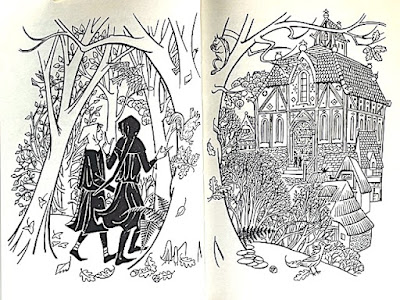When one picks up a copy of Smith of Wootton Major and Farmer Giles of Ham you are getting one of J.R.R. Tolkien's earliest works alongside his final published work in his lifetime. These two stories are often sold together for two reasons, they both operate within Tolkien's fairy world, and both are quite short. Farmer Giles of Ham was first written in 1937 and published in 1949 while Smith of Wootton Major was published in 1967 and began as an essay on fairies but then Tolkien just decided to write a children's story instead.
I first encountered these two tales when I picked up the sleek and handsome Ballantine Books paperback with the two stories. The cover showing Father Giles talking to the dragon Chrysophylax was a test for the Brothers Hildebrandt to see if they were up to painting more pieces for Ballantine's already successful Tolkien publications.
Farmer Giles of Ham begins when his faithful dog Garm decides to raise the alarm that a giant decides to wander onto the property. Giles uses a blunderbuss full of nails and such to repel the giant. He becomes a local hero and is rewarded by the King with a neglected sword from the armory. Later the giant tells the dragon Chrysophylax that he found no knights in the little kingdom. That inspires the dragon to travel and begin to cause trouble by destroying property and gobbling up friars and suchlike. Giles is pressed to do something about it and is obviously reluctant,
Turns out that the sword is called "Tailbiter" and is especially keen to kill dragons. The dragon is cowed and negotiates a deal to enrich the people if they let him go. They do and he reneges. The King wants those riches and sends Giles and more knights to get it. When Giles confronts Chrysophylax a second time, he comes up with a different scheme.
This a lovely breezy whimsical story with lots of humor. Garm the dog is especially the focus of several jokes. The King is presented as a greedy bastard and deserves what he gets. The dragon is also a specific personality, not a wily I suppose as the more famous Smaug, but certainly of a devious bent. There's a haplessness to Farmer Giles at first, but he changes, not something that always happens in stories of this sort.
The Smith of Wootton Major is a more somber story about how the magic of the fairies can slip into our world in almost unknown ways and delightful and lasting effects. The story takes place of course in a small village called Wootton Major and concerns a tradition of baking special cakes every twenty-four years for children who are lucky enough to have the right birthday. When the regular baker leaves unexpectantly his young apprentice is looked upon to help a substitute baker fill the order. That young apprentice is a quiet young man who himself does eventually become the baker.
But the focus of the story is on a young boy named Smith who is at that party and gets a special prize in his piece of cake, a dazzling white star that gets embedded on his forehead and which seems to give him the power to perceive and even travel to the land of the fairies.
But as a man and a husband and a father he meets the young man who was the baker and learns the true nature of gifts. What Smith decides to do warms the heart of any reader.
I heartily enjoy both these stories and it's difficult to choose between them. But if pressed I'd have tos ay that the humor in the story of Farmer Giles and his dog Garm wins the day. These stories have been available in various collections over the years and currently you can find them both in Tales from the Perilous Realm along with many other of Tolkien's lighter supernatural tales.
Rip Off






.jpg)




I hadn't heard of Farmer Giles Of Ham before but I certainly know the name "Farmer Giles" because it's a sort of jokey term for an average British farmer and that's why Tolkien used it - he knew his readership would understand the kind of person he meant.
ReplyDeleteGood information. That adds a lot to my understanding of what Tolkien was at in the story.
Delete